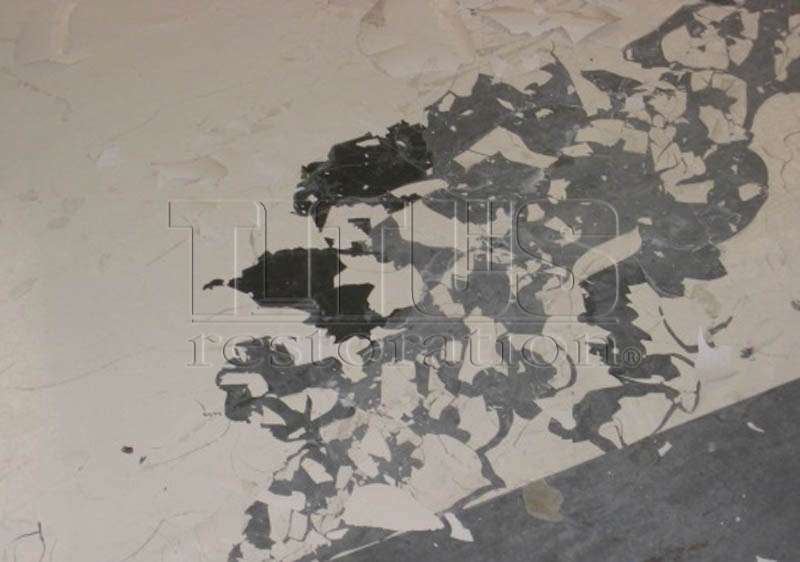There are many reasons that epoxy floor coatings fail. One of them is epoxy failure due to moisture content in the concrete slab. Notice the dark areas on the concrete? This is surface moisture coming from within the concrete slab.
Fixing a Wet Concrete Floor

Wet concrete, as a result of moisture vapor drive in the concrete slab is causing this epoxy floor coating to peel and crack
In the picture above, it is apparent that the surface was not properly abraded to receive a coating, which is another reason for many epoxy coating failures, however even if properly abraded, this floor had too much moisture content and would probably have failed anyway (read more about preparing a concrete floor to be painted). The following paragraphs will tell you how to fix a wet concrete floor so it can be painted and prevent epoxy failure due to moisture.
Moisture Testing Prior to Coating Concrete
One way to eliminate epoxy floor coating failure is to test it before you coat it. There are two tests that are typically used, one is a calcium chloride test (ASTM F1860-11 Standard) and the other is an in situ relative humidity test (ASTM F2170-11). It is important to use the test required by the floor coating manufacturer and to abide by the manufacturer’s moisture content requirements when applying the coatings.
The Calcium Chloride Moisture Test
The calcium chloride moisture use in the flooring industry dates back to the early 1940’s. It was invented by the Rubber Manufacturers Assn., Inc. This test measures the moisture in the top ½ to ¾ inches of the floor. It is generally accepted that a reading of 3 to 5 lbs. moisture vapor transmission per 1000 square feet is acceptable for coatings, but one must defer to the manufacturers’ application directions.
The In Situ Relative Humidity Test
Measuring the relative humidity within a slab is considerably newer technology. This type of concrete moisture testing requires drilling a hole in the concrete and inserting an electronic probe. The hole is drilled to 40% of the depth of the slab and the moisture content at that level is read in terms of relative humidity (rh). It is generally accepted that a reading of 75% rh is acceptable for coatings, but again, one must defer to the manufacturers’ application directions.
How to Paint Over Wet Concrete
If the slab is wet, there are epoxy coatings that can be applied over damp and wet concrete as a primer and then the desired top coat can be applied. Again, it is best to follow the manufacturer’s recommendations. If you use one manufacturer’s coating for moisture remediation and another manufacturer’s coating as a top coat without written consent from both, any failure could end in finger pointing and a void warranty
